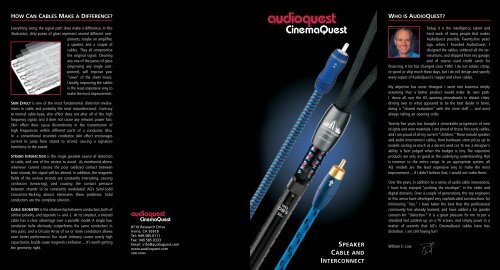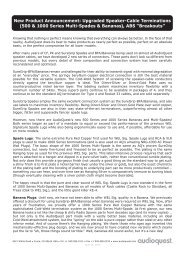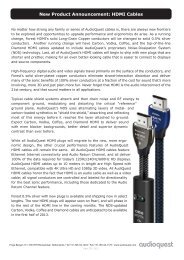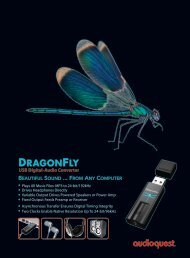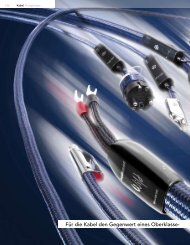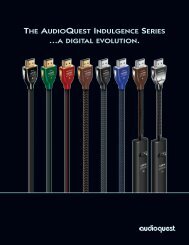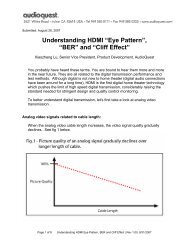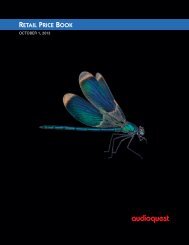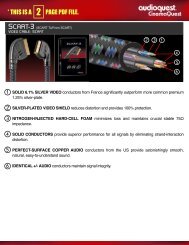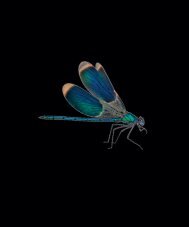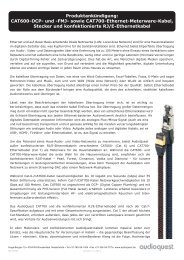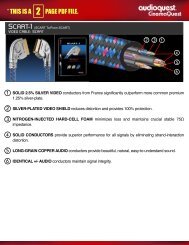04249 AQSPKRBrochure REV - Audioquest
04249 AQSPKRBrochure REV - Audioquest
04249 AQSPKRBrochure REV - Audioquest
Create successful ePaper yourself
Turn your PDF publications into a flip-book with our unique Google optimized e-Paper software.
HOW CAN CABLES MAKE A DIFFERENCE?<br />
WHO IS AUDIOQUEST?<br />
Everything along the signal path does make a difference. In this<br />
illustration, dirty panes of glass represent several different components,<br />
maybe an amplifier,<br />
a speaker, and a couple of<br />
cables. They all compromise<br />
the original signal. Cleaning<br />
any one of the panes of glass<br />
(improving any single component),<br />
will improve your<br />
“view” of the sheet music.<br />
Usually, improving the cables<br />
is the least expensive way to<br />
make the most improvement.<br />
SKIN EFFECT is one of the most fundamental distortion mechanisms<br />
in cable, and probably the most misunderstood. Contrary<br />
to normal cable-hype, skin effect does not alter all of the high<br />
frequency signal, and it does not cause any relevant power loss.<br />
Skin effect does cause discontinuity in the transmission of<br />
high frequencies within different parts of a conductor. Also,<br />
in a conventional stranded conductor, skin effect encourages<br />
current to jump from strand to strand, causing a signature<br />
harshness to the sound.<br />
STRAND INTERACTION is the single greatest source of distortion<br />
in cable, and one of the easiest to avoid. As mentioned above,<br />
whenever current crosses the poor oxidized contact between<br />
bare strands, the signal will be altered. In addition, the magnetic<br />
fields of the various strands are constantly interacting, causing<br />
confusion (smearing), and causing the contact pressure<br />
between strands to be constantly modulated. AQ’s Semi-Solid<br />
Concentric-Packing almost eliminates these problems. Solid<br />
conductors are the complete solution.<br />
CABLE GEOMETRY is the relationship between conductors, both of<br />
similar polarity, and opposite (+ and -). At its simplest, a twisted<br />
cable has a clear advantage over a parallel model. A single four<br />
conductor helix obviously outperforms the same conductors in<br />
two pairs, and a Circular Array of six or more conductors allows<br />
even better performance. Too much intimacy causes overly high<br />
capacitance, braids cause magnetic confusion ... It’s worth getting<br />
the geometry right.<br />
8710 Research Drive<br />
Irvine, CA 92618<br />
Tel: 949.585.0111<br />
Fax: 949.585.0333<br />
Email: info@audioquest.com<br />
www.audioquest.com<br />
2480-03049<br />
SPEAKER<br />
CABLE AND<br />
INTERCONNECT<br />
Today, it is the intelligence, talent and<br />
hard work of many people that makes<br />
AudioQuest possible. Twenty-five years<br />
ago, when I founded AudioQuest, I<br />
designed the cables, soldered all the terminations,<br />
and shipped from my garage;<br />
and of course used credit cards for<br />
financing. A lot has changed since 1980. I do not solder, crimp,<br />
re-spool or ship much these days, but I do still design and specify<br />
every aspect of AudioQuest’s copper and silver cables.<br />
My objective has never changed. I went into business simply<br />
assuming that a better product would make its own path.<br />
I drove all over the US, opening phonebooks in distant cities,<br />
driving over to what appeared to be the best dealer in town,<br />
doing a “shared evaluation” with the store staff ... and most<br />
always taking an opening order.<br />
Twenty-five years has brought a remarkable progression of new<br />
insights and new materials. I am proud of those first early cables,<br />
and I am proud of all my current “children.” These include speaker<br />
and audio interconnect cables, from hardware store prices up to<br />
models costing as much as a decent used car. To me, a designer’s<br />
ability is best judged when the budget is tiny. The expensive<br />
products are only as good as the underlying understanding that<br />
is common to the entire range. In an appropriate system, all<br />
AQ models are the least expensive way to make the most<br />
improvement ... if I didn’t believe that, I would not make them.<br />
Over the years, in addition to a series of audio cable innovations,<br />
I have truly enjoyed “pushing the envelope” in the video and<br />
digital domains. Over a couple of generations, the top engineers<br />
in this arena have developed very sophisticated constructions for<br />
minimizing “loss.” I have taken the best that this professional<br />
community has already learned, and have added a far greater<br />
concern for “distortion.” It is a great pleasure for me to put a<br />
standard test pattern up on a TV screen, and simply prove in a<br />
matter of seconds that AQ’s CinemaQuest cables have less<br />
distortion. I am still having fun!<br />
William E. Low
CONDUCTOR MATERIAL QUALTITY<br />
Conductor material quality makes a world of difference. However,<br />
the best materials will not rescue an inferior design. Impurities in<br />
the conducting material cause a harshness signature similar to<br />
strand interaction. The best materials have very long grain<br />
structures and superior contact between the grains… all that<br />
going on inside every single strand! The quality of a conductive<br />
path is most defined by a conductor’s surface. The surface is a<br />
meeting of the area of greatest current density inside the<br />
conductor, and of the greatest external magnetic field density.<br />
The surface is like a rail-guide for the entire energy envelope.<br />
Model Construction Metal Features Gauge/Sq. mm Jacket<br />
G-2 Concentric<br />
LGC SST, SSCP 16 / 1.23<br />
X-2 LGC SST, SSCP 14 / 1.94<br />
G-4 Flat Concentric<br />
LGC SST, SSCP 15 / 1.56<br />
X-4 LGC SST, SSCP 13 / 2.65<br />
TYPE 1<br />
CV-1 PSC+ / PSC SST 16 / 1.34<br />
TYPE 2<br />
Flat Solid<br />
Quad Helix HyperLitz<br />
LGC SST 16 / 1.34<br />
LGC SST, UL/CL-3 16 / 1.23<br />
CF Spade (S or G)<br />
CF BFA (S or G)<br />
CONDUCTING MATERIALS<br />
OFHC - Oxygen Free High-Conductivity copper has less oxygen (less copper<br />
oxides) inside the conducting material, therefore less distortion. Should<br />
properly be called “Oxygen Reduced.”<br />
LGC - There is a lot of variation in the quality of OFHC, because it is specified<br />
for its conductivity, not for its distortion profile. Low distortion OFHC has an<br />
exceptionally long grain structure, hence the name Long-Grain Copper.<br />
PSC - Perfect-Surface Copper. As only the surface of a conductor has 100%<br />
current density and magnetic field density at all frequencies, the surface most<br />
defines the sound quality of the whole conductor.<br />
PSC+ - This higher purity version of PSC is simply that much closer to not<br />
being in the way at all.<br />
PSS - Perfect-Surface technology applied to extremely high purity solid Silver.<br />
INSULATION MATERIAL QUALTITY<br />
Insulation material quality is a major source of distortion in a<br />
low level cable. Air is the best, so the best cables include as<br />
much air as possible. Solid materials all affect the signal, and are<br />
best chosen for the nature of their distortion, for having a lack<br />
of discernible character. “Low loss” is not itself important, as the<br />
little bit that is lost is not heard. The energy that is stored and<br />
then released back into the conductor is out of phase. This will<br />
either rob intelligibility (be dull), or add irritation (be bright).<br />
DIELECTRIC-BIAS SYSTEM (DBS)<br />
Batteries on a cable? In addition to insulating and<br />
protecting a conductor, insulation is also a<br />
“dielectric.” While insulating ability is defined by<br />
how well insulation can block current, a dielectric<br />
is defined by how much it will slow down a<br />
signal; known as time delay or “phase shift.”<br />
Time delay cannot be completely prevented, but<br />
the damage it causes can be dramatically<br />
reduced. When the molecules of the insulation are<br />
electrically unorganized, the time delay is different<br />
for every frequency and for every signal level.<br />
In much the same way that a magnetic field causes<br />
a compass to point in a certain direction, the AQ DBS<br />
system creates a fixed stable field which electrostatically<br />
organizes (polarizes) the insulation. Once<br />
organized, the insulation no longer causes multiple<br />
nonlinear time delays. Sound appears from a surprisingly<br />
black background with much better preserved<br />
clarity and dynamic contrast.<br />
The 12V hardware-store batteries used in the AQ<br />
DBS packs will last for years because they are only<br />
used to maintain an electric field; there is no closed<br />
circuit, no drain on the batteries. A test button and<br />
SPEAKER CABLE<br />
AUDIO INTERCONNECT CABLE<br />
TYPE 4<br />
LGC SST, UL/CL-3 15 / 1.56<br />
CV-4 PSC+ / PSC 36v DBS, SST, UL/CL-3 15 / 1.56<br />
KE-4 PSS 72v DBS, SST, UL/CL-3 15 / 1.56<br />
TYPE 6 Circular Helix HyperLitz<br />
LGC SST, SBW, UL/CL-3 13 / 2.65<br />
CV-6 PSC+ / PSC 36v DBS, SST, SBW, UL/CL-3 13 / 2.65<br />
KE-6 PSS 72v DBS, SST, SBW, UL/CL-3 13 / 2.65<br />
SLATE<br />
ROCKEFELLER<br />
Double Quad Helix “Flat Rocks”<br />
LGC SST, SBW 12 / 3.49<br />
PSC+/PSC 36v DBS, SST, SBW 12 / 3.49<br />
GIBRALTAR PSC+ 36v DBS, SST, SBW 12 / 3.49<br />
PIKES PEAK Counter Spiral “Earth Features” PSC+ / PSC 36v DBS, SST, SBW 11 / 3.87<br />
MONT BLANC PSC+ 72v DBS, SST, SBW 11 / 3.87<br />
VOLCANO PSC+ 72v DBS, SST, SBW 9 / 5.94<br />
KILIMANJARO PSS 72v DBS, SST, SBW 11 / 3.87<br />
EVEREST PSS 72v DBS, SST, SBW 9 / 5.94<br />
Model XLR Metal/Features<br />
ALPHA-SNAKE<br />
G-SNAKE<br />
SIDEWINDER<br />
COPPERHEAD<br />
DIAMONDBACK<br />
NA<br />
NA<br />
NA<br />
NA<br />
Solid LGC Copper<br />
Symmetrical Coax<br />
AQ Solder<br />
Solid LGC Copper<br />
Symmetrical Coax<br />
AQ Solder<br />
UL/CL-3 Available<br />
Solid LGC Copper<br />
Symmetrical Coax<br />
AQ Solder<br />
Foamed PE<br />
Solid PSC Copper<br />
Symmetrical Coax<br />
AQ Solder<br />
Foamed PE<br />
Solid PSC Copper<br />
Triple Balanced<br />
Welded, Silver-Plated Plug<br />
PE Air-Tubes<br />
AUDIO INTERCONNECT CABLE<br />
Model<br />
KING COBRA<br />
JAGUAR<br />
PANTHER<br />
CHEETAH<br />
SKY<br />
TERMINATION OPTIONS<br />
XLR<br />
CF UST (S or G)<br />
UST Spade (S or G)<br />
UST Pin (S or G)<br />
Metal/Features<br />
Solid PSC+ Copper<br />
Welded, Silver-Plated Plug<br />
PE Air-Tubes<br />
Solid PSC+ Copper<br />
Welded, Silver-Plated Plug<br />
PE Air-Tubes<br />
36V DBS<br />
Solid PSC+ Copper<br />
Welded OCC Plugs<br />
Teflon Air-Tubes<br />
36V DBS<br />
Solid PSS Silver<br />
Welded OCC Plugs<br />
Teflon Air-Tubes<br />
36V DBS<br />
Solid PSS Silver<br />
Welded OCC Plugs<br />
Large Teflon Air-Tubes<br />
72V DBS<br />
SPEAKER CABLE CONSTRUCTIONS<br />
Stranded - Normal random bunched conductors have lots of strandinteraction<br />
generated distortion.<br />
SSCP - Semi-Solid Concentric Packing: Tightly packed strands in a uniform<br />
non-changing arrangement drastically reduce inter-strand electrical and<br />
magnetic distortions.<br />
Solid - No strand interaction distortion at all.<br />
HyperLitz® - Solid conductors arranged in a fixed relationship, to prevent<br />
skin-effect and minimize magnetic interaction.<br />
SST - Spread-Spectrum Technology uses multiple size conductors to greatly<br />
reduce awareness of individual conductor character flaws.<br />
Counter Spiraling Helixes -Two circular arrays spiraling in opposite<br />
directions. Positive and negative conductors cross, reducing interaction, even<br />
while maintaining a crucial constant relationship between (+) and (-).<br />
SBW - These cables are ideal for full range (all + and - in two groups) and<br />
for Single-BiWire (+ and - in four groups).<br />
INTERCONNECT CABLE CONSTRUCTIONS<br />
Coax - Most interconnect cables have a “positive” center conductor, and use<br />
the shield as (an inferior) “negative” conductor.<br />
Symmetrical Coax - A foil shield combined with a low distortion conductor<br />
identical to the center conductor, provides a negative path symmetrical with<br />
the positive center conductor.<br />
Triple Balanced - Necessary to provide equal paths for all signals in<br />
balanced (XLR) applications. In Single-Ended (RCA) applications, distortion<br />
is reduced by doubling the negative path, as there is far greater “potential”<br />
across this connection.<br />
INTERCONNECT CABLE INSULATIONS<br />
PVC - Polyvinyl Chloride is under-appreciated because it is too “lossy” to use<br />
in wideband cables. PVC’s “friendly” distortion profile makes it very cost<br />
effective for audio.<br />
PE - Polyethylene absorbs less energy than PVC, and also has a very<br />
“friendly” sonic signature.<br />
Foam PE - Filling PE with air creates Foamed PE, a much better dielectric,<br />
significantly improving clarity and dynamics.<br />
PE Tubes - Solid PE tubes with an inner diameter (ID) much larger than the<br />
outer diameter (OD) of the metal inside. Air becomes the primary insulation!<br />
Teflon Tubes - Even though PETubes have mostly air for insulation, the PE still<br />
affects the sound. Teflon tubes further improve performance.


